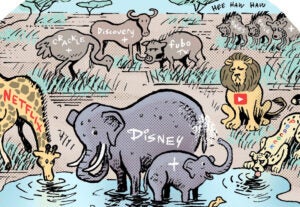Canned audiences are as stale as cigarette smoke in an old casino.
That’s why MGM Resorts International is looking for alternatives to what Kelly Smith, MGM’s SVP and chief digital officer, calls “black-box syndicated segments.”
In its quest for custom audience activation, MGM is kicking the tires on a new self-serve data marketplace offering from mobile data platform PushSpring, which came out of beta on Wednesday.
“Our business is as much about hospitality, entertainment, food and beverage and being a retailer as it is about gaming,” Smith said. “In fact, most of our revenue doesn’t come from gaming. And so we’re looking for wine-loving frequent travelers who’re into luxury goods – and it’s not easy to get that at scale.”
The PushSpring marketplace is like an ecommerce hub for data buying.
PushSpring aggregates deterministic, unmodeled data from numerous sources, including its own SDK and data that comes through partnerships with providers, such as V12 Data, Sprint subsidiary Pinsight Media and Ericsson-owned Placecast, and serves it through a searchable console.
Any cookie data PushSpring gets from third-party providers is cross-matched with deterministic identifiers, usually a mobile ad ID, through LiveRamp’s IdentityLink service. Although matching against a probabilistic graph would yield more scale, PushSpring opted to sacrifice volume for accuracy, said Karl Stillner, CEO and co-founder of PushSpring.
Buyers can browse for data sets by data type or run keyword searches such as “big-box retailer visitors” or “fashionistas with a profile on Polyvore.” Buyers can also see data recommendations based on previously searched data sets and related audiences.
Each segment comes with information on where the data was sourced, the methodology used to collect it and direct links to the data provider’s privacy policy.
Agencies and advertisers can’t usually see the ingredients of a data set they’re buying, said Tim Woitkun, VP of digital strategy and marketing at Havas.
“Off-the-shelf audiences are often a mystery and building a custom audience in real time at scale has been a challenge,” Woitkun said.
The marketplace also allows buyers to combine multiple data sets and create custom segments they can purchase for a transparent, fixed price. Buyers activate through their DSP of choice; PushSpring is integrated with most of the biggies, including inMobi, DataXu, The Trade Desk and Adform.
The goal is to make media buying as easy and frictionless as possible, said PushSpring’s Stillner.
“We’re trying to democratize data access,” he said, “not turn media planners and buyers into data scientists.”
Ease of use is a top priority for an enormous company like MGM, which at 77,000 is the largest employer in Nevada.
“Our size makes it key to have organizational alignment across different marketing functions related to audiences, data, analytics and programmatic activation,” Smith said. “And most of the people who work in our marketing department didn’t come from a digital background, so they need tools that are intuitive to use and don’t require a lot of explanation.”
Better insight into what data is being used also enables advertisers to have a “more fruitful” relationship with their agency partners, Smith said.
“In digital, it’s increasingly important to be more involved in your outsourced relationships,” he said. “You can’t just throw things over the wall and have them fall into a black box. Knowing what’s going on is a requirement for digital transformation.”
Agencies feel the same way.
“[Self service] allows us more control and provides confidence to know that we can quickly create a meaningful audience per our objectives,” Woitkun said. “We have dedicated people who are hands on keyboards day in and day out within our agency, and that team continues to grow year over year.”














